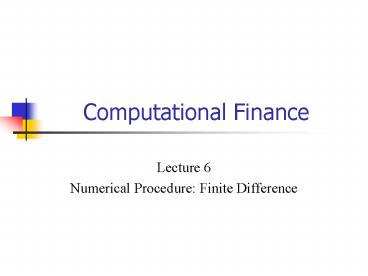Computational Finance - PowerPoint PPT Presentation
1 / 31
Title:
Computational Finance
Description:
Review of Black-Scholes Formula. must satisfy the following PDE: and. Review of Black-Scholes Formula. Black-Scholes formula: European call: European put: ... – PowerPoint PPT presentation
Number of Views:25
Avg rating:3.0/5.0
Title: Computational Finance
1
Computational Finance
- Lecture 6
- Numerical Procedure Finite Difference
2
Review of Black-Scholes Formula
- must satisfy the following PDE
- and
3
Review of Black-Scholes Formula
- Black-Scholes formula
- European call
- European put
- where
4
Some Extensions to Black-Scholes Formula
- But we assumed non-dividend stocks as the
underlying assets when deriving the B-S formula. - How about other kinds of assets?
5
Options on Dividend-Paying Stocks
- Options on dividend-paying stocks
- Usually stock prices will go down by an amount at
the dividend payable date reflecting the dividend
paid per share. - So we should take this change on the stock price
into account when pricing options based upon such
securities.
6
Options on Dividend-Paying Stocks
- We can view the whole stock prices as the sum of
two parts - Riskless component that corresponds to the known
dividend during the life of the option - Risky component.
- Reset to be the current stock price minus the
present value of dividends. Then we can use the
B-S formula.
7
Options on Dividend-Paying Stocks
- Consider a 6-month European call option on a
stock when there are two dividend payments
expected in two months and five months. - The dividend of each payment is expected to be
0.5. - Current stock price 40, volatility 30 per
annum, risk free interest 9 per annum - Strike price 40
8
Options on Dividend-Paying Stocks
- The present value of the dividends is
- The stock price after deduction
- Plugging in B-S formula,
9
Currency Options
- Recall that in the binomial tree model to
duplicate options on currencies, we use a
portfolio of foreign currency and risk free
saving account. - Foreign currency generates interests according to
foreign risk-free interest rates, which is
different from the domestic risk-free interest
rate.
10
Currency Options
- So, such options can be viewed as options on an
underlying asset with continuous-time-paying
dividends.
11
Currency Options
- Consider a four-month European call option traded
in the US market on the British pound. - Current exchange rate US1.3/pound
- Strike price US1.4/pound
- Risk free interest rates 2 in US, 3 in UK
- Exchange rate volatility 20
12
Some Extensions of Black-ScholesCurrency Options
- The duplication argument will lead to
- The B-S formula then is transformed to
13
Some Extensions of Black-ScholesCurrency Options
- In the previous example, the interest rate in US
is considered as domestic and the one in UK as
foreign
14
Some Extensions Black-Scholes Can Not Handle
- How to price American options is still open so
far. That is why we introduce numerical methods
to overcome the difficulty.
15
Grids
- associates a pair of t and S with the
value of an option when time is t and the
underlying asset price is S. - S
- T t
16
Grids
- Impossible to calculate all values for each pair
of t and S - Finite difference method is to calculate the
values at the nodes of a grid. - S
-
t
17
Node Labels
- Introduce the following labels to simplify our
notations - for node (t, S), we denote it by (i, j) if
- We intend to calculate
18
Boundary Conditions
- The values at some nodes are clear
19
Black-Scholes PDE
- But we do not know the values for most of nodes.
- We would like to derive some relationship among
nodes via Black-Scholes PDE
20
Differentiation on Grids
- Approximating Theta
- If the distance of time grid is , then
21
Differentiation on Grids
- Approximating Delta
- We can use the following Taylor expansion
- Then,
22
Differentiation on Grids
- Approximating Gamma
- By Taylor expansion,
- Then,
23
Explicit Finite Difference Method
- Plugging all of the approximations back to PDE,
we have
24
Explicit Finite Difference Method
- After rearrangement,
- where
25
Explicit Finite Difference Method
- Under our labeling system, the recursion becomes
- where
26
Explicit Finite Difference Method
- Relationship in the explicit finite difference
method - S
-
t
is calculated from there
Option Value
27
Pseudo Codes
- Pseudo codes
- Suppose that
- Set values for all V(M, j)
- For i M to 0
- Calculate
- end
28
One Tip Truncation of Stock Price Range
- In theory, stock price could be any number from 0
to infinity. But it is impossible to calculate
infinite numbers in a computer. - We truncate the range of stock price to be finite
by choosing a sufficiently high value, .
29
One Tip Truncation of Stock Price Range
- The recursion relation does not work for nodes at
the boundary. - One convention is as follows
- Call option
- Put option
30
Numerical Example
- Pricing a European put with strike price 50 and
maturity in 5 months. The underlying stock is
non-dividend-paying and the current price is 40
and its volatility is 40 per year. The risk free
interest rate is 10 per year.
31
American Options Pricing
- American options entitle the right of early
exercising. - When implementing finite difference for American
options, we need to evaluate every node taking
such right into account.































